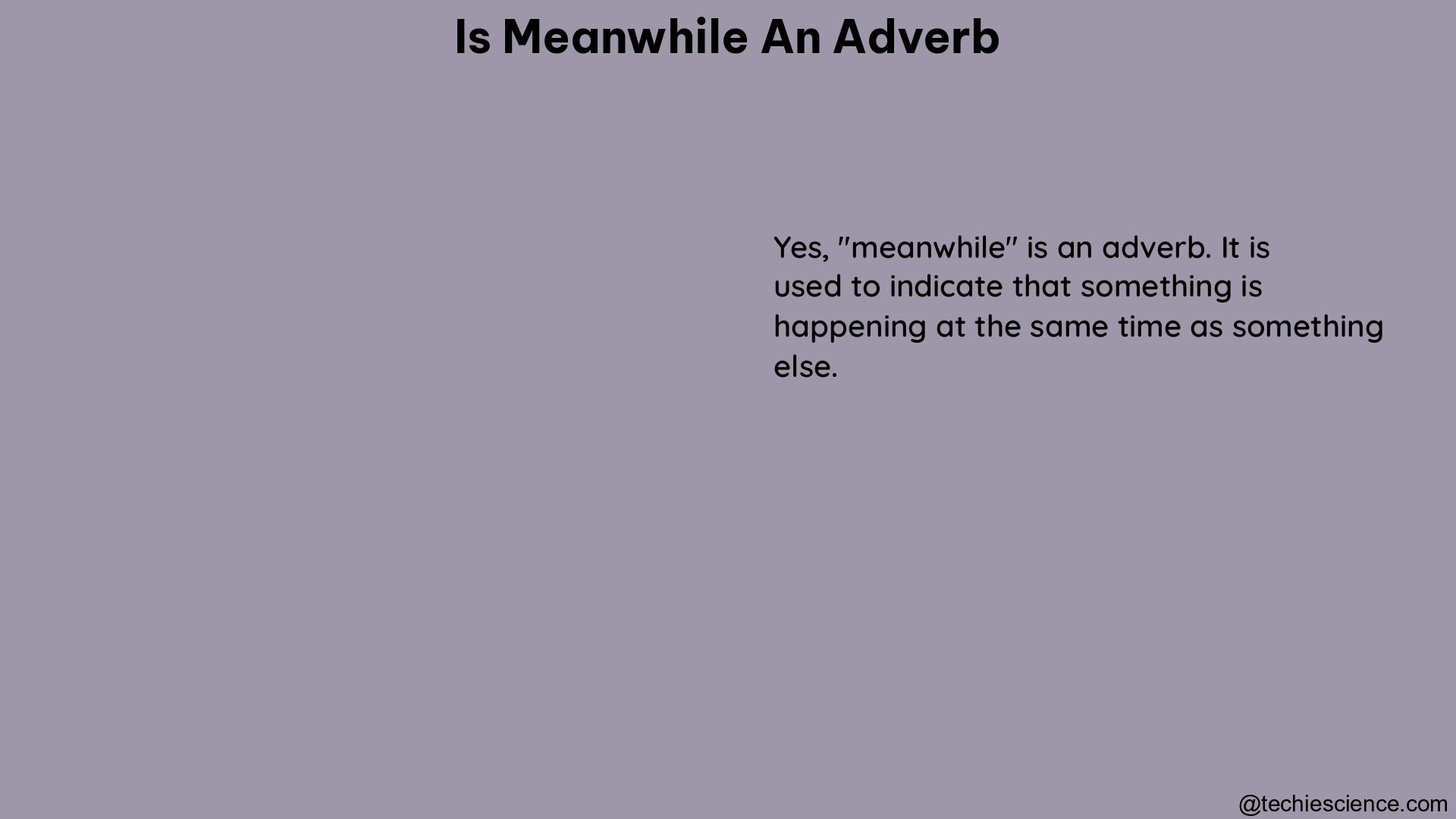Yes, “meanwhile” is an adverb. It is used to indicate that two events are happening simultaneously or that one event is occurring during the time before another event takes place.
Grammatical Specification of “Meanwhile”
Pronunciation
- UK: /ˈmiːn.waɪl/
- US: /ˈminwaɪl/
Part of Speech
“Meanwhile” is classified as an adverb.
Usage of “Meanwhile” as an Adverb

1. Simultaneous Events
- “You can set the table, and meanwhile I’ll start cooking dinner.” (Both actions are happening at the same time)
- “She spent four years studying for her law degree. Meanwhile, she continued to work at the bank.” (Two events happening concurrently)
2. Time Before an Event
- “The pizza will be ready in 10 minutes, Mum. Great – meanwhile, let’s set the table.” (Action happening before the pizza is ready)
- “I have an interview in an hour, but meanwhile I’m going to take a nap.” (Action happening before the interview)
3. Comparing Aspects
- “Stress can be extremely damaging to your health. Exercise, meanwhile, can reduce its effects.” (Comparing two aspects of a situation)
Detailed Grammatical Analysis
Adverb of Time
“Meanwhile” is classified as an adverb of time because it indicates the timing or duration of an action or event. It specifically denotes that two events are happening concurrently or that one event is occurring during the time before another event takes place.
Sentence Position
As an adverb, “meanwhile” can be placed in different positions within a sentence:
- Beginning of the Sentence:
-
“Meanwhile, the team continued to work on the project.”
-
Middle of the Sentence:
-
“The team, meanwhile, continued to work on the project.”
-
End of the Sentence:
- “The team continued to work on the project, meanwhile.”
The placement of “meanwhile” can affect the emphasis and flow of the sentence, but the meaning remains the same.
Punctuation
When “meanwhile” is used to connect two independent clauses, it is often separated by a comma:
– “The team finished their presentation, meanwhile the client reviewed the proposal.”
However, when “meanwhile” is used within a single clause, it may not require a comma:
– “You can start cooking the pasta meanwhile I set the table.”
The use of punctuation with “meanwhile” can vary depending on the specific sentence structure and the writer’s style preferences.
Alternatives to “Meanwhile”
There are other adverbs that can be used to express a similar meaning as “meanwhile”:
- “In the meantime”
- “At the same time”
- “Concurrently”
- “Simultaneously”
These adverbs can be used interchangeably with “meanwhile” in many contexts, depending on the desired emphasis and flow of the sentence.
Conclusion
In summary, “meanwhile” is an adverb that is used to indicate the simultaneous occurrence of two events or the timing of one event in relation to another. It is a versatile adverb that can be positioned in various parts of a sentence to convey the desired meaning and emphasis. Understanding the grammatical specification and usage of “meanwhile” is crucial for effective and precise communication in the English language.
References
- Cambridge English Dictionary. (n.d.). Meanwhile. Retrieved from https://dictionary.cambridge.org/us/dictionary/english/meanwhile
- Oxford Learner’s Dictionaries. (n.d.). Meanwhile. Retrieved from https://www.oxfordlearnersdictionaries.com/us/definition/american_english/meanwhile
- Dictionary.com. (n.d.). Meanwhile. Retrieved from https://www.dictionary.com/browse/meanwhile
- Merriam-Webster. (n.d.). Meanwhile. Retrieved from https://www.merriam-webster.com/dictionary/meanwhile
- Vocabulary.com. (n.d.). Meanwhile. Retrieved from https://www.vocabulary.com/dictionary/meanwhile
Hi… I am Sowndharya Jagadeeswaran, a university rank holder in M.A. English Literature. I have also done my master’s in Business Administration. Inquisitive as I am, my interest in action-oriented research helped me publish research papers in reputed journals. Now, as a career, I am an instructor where I teach young and adorable students the intricate technicalities of Public Speaking and Creative Writing. I also enjoy writing articles on topics I specialize and research in.
You can connect with me through LinkedIn.-